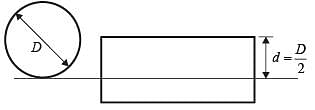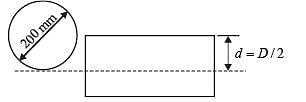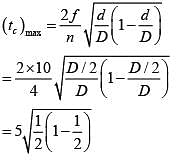Mechanical Engineering Exam > Mechanical Engineering Questions > A straight-teeth horizontal slab milling cutt...
Start Learning for Free
A straight-teeth horizontal slab milling cutter is shown in the figure. It has 4 teeth and diameter (D) of 200 mm. The rotational speed of the cutter is 100 rpm and the linear feed given to the workpiece is 1000 mm/minute. The width of the workpiece (w) is 100 mm, and the entire width is milled in a single pass of the cutter. The cutting force/tooth is given by F = Ktc w , where specific cutting force K = 10 N/mm2, w is the width of cut, and tc is the uncut chip thickness.
The depth of cut (d) is D/2, and hence the assumption of is invalid. The maximum cutting force
is invalid. The maximum cutting force
required is ________ kN (round off to one decimal place).
The depth of cut (d) is D/2, and hence the assumption of
 is invalid. The maximum cutting force
is invalid. The maximum cutting force required is ________ kN (round off to one decimal place).

Correct answer is between '2.3,2.7'. Can you explain this answer?
| FREE This question is part of | Download PDF Attempt this Test |
Most Upvoted Answer
A straight-teeth horizontal slab milling cutter is shown in the figure...
Given,

Number of teeths (n) = 4
Diameter of cutter (D) = 200 mm
Rotational speed ( N ) = 100 rpm
Width of workpiece (w) = 100 mm
Depth of cut (d) = D/2
Feed
 = 10 mm/rev
= 10 mm/revMaximum uncut chip thickness is given by,

= 5 x 1/2
= 2.5 mm
Maximum force is given by, Fmax = k(tc)max w
=10 x 2.5 x 100
= 2500 N
= 2.5 kN
Hence, the maximum cutting force required is 2.5 kN.
Attention Mechanical Engineering Students!
To make sure you are not studying endlessly, EduRev has designed Mechanical Engineering study material, with Structured Courses, Videos, & Test Series. Plus get personalized analysis, doubt solving and improvement plans to achieve a great score in Mechanical Engineering.

|
Explore Courses for Mechanical Engineering exam
|

|
Similar Mechanical Engineering Doubts
A straight-teeth horizontal slab milling cutter is shown in the figure. It has 4 teeth and diameter (D) of 200 mm. The rotational speed of the cutter is 100 rpm and the linear feed given to the workpiece is 1000 mm/minute. The width of the workpiece (w) is 100 mm, and the entire width is milled in a single pass of the cutter. The cutting force/tooth is given by F = Ktc w , where specific cutting force K = 10 N/mm2, w is the width of cut, and tc is the uncut chip thickness.The depth of cut (d) is D/2, and hence the assumption ofis invalid. The maximum cutting forcerequired is ________ kN (round off to one decimal place).Correct answer is between '2.3,2.7'. Can you explain this answer?
Question Description
A straight-teeth horizontal slab milling cutter is shown in the figure. It has 4 teeth and diameter (D) of 200 mm. The rotational speed of the cutter is 100 rpm and the linear feed given to the workpiece is 1000 mm/minute. The width of the workpiece (w) is 100 mm, and the entire width is milled in a single pass of the cutter. The cutting force/tooth is given by F = Ktc w , where specific cutting force K = 10 N/mm2, w is the width of cut, and tc is the uncut chip thickness.The depth of cut (d) is D/2, and hence the assumption ofis invalid. The maximum cutting forcerequired is ________ kN (round off to one decimal place).Correct answer is between '2.3,2.7'. Can you explain this answer? for Mechanical Engineering 2024 is part of Mechanical Engineering preparation. The Question and answers have been prepared according to the Mechanical Engineering exam syllabus. Information about A straight-teeth horizontal slab milling cutter is shown in the figure. It has 4 teeth and diameter (D) of 200 mm. The rotational speed of the cutter is 100 rpm and the linear feed given to the workpiece is 1000 mm/minute. The width of the workpiece (w) is 100 mm, and the entire width is milled in a single pass of the cutter. The cutting force/tooth is given by F = Ktc w , where specific cutting force K = 10 N/mm2, w is the width of cut, and tc is the uncut chip thickness.The depth of cut (d) is D/2, and hence the assumption ofis invalid. The maximum cutting forcerequired is ________ kN (round off to one decimal place).Correct answer is between '2.3,2.7'. Can you explain this answer? covers all topics & solutions for Mechanical Engineering 2024 Exam. Find important definitions, questions, meanings, examples, exercises and tests below for A straight-teeth horizontal slab milling cutter is shown in the figure. It has 4 teeth and diameter (D) of 200 mm. The rotational speed of the cutter is 100 rpm and the linear feed given to the workpiece is 1000 mm/minute. The width of the workpiece (w) is 100 mm, and the entire width is milled in a single pass of the cutter. The cutting force/tooth is given by F = Ktc w , where specific cutting force K = 10 N/mm2, w is the width of cut, and tc is the uncut chip thickness.The depth of cut (d) is D/2, and hence the assumption ofis invalid. The maximum cutting forcerequired is ________ kN (round off to one decimal place).Correct answer is between '2.3,2.7'. Can you explain this answer?.
A straight-teeth horizontal slab milling cutter is shown in the figure. It has 4 teeth and diameter (D) of 200 mm. The rotational speed of the cutter is 100 rpm and the linear feed given to the workpiece is 1000 mm/minute. The width of the workpiece (w) is 100 mm, and the entire width is milled in a single pass of the cutter. The cutting force/tooth is given by F = Ktc w , where specific cutting force K = 10 N/mm2, w is the width of cut, and tc is the uncut chip thickness.The depth of cut (d) is D/2, and hence the assumption ofis invalid. The maximum cutting forcerequired is ________ kN (round off to one decimal place).Correct answer is between '2.3,2.7'. Can you explain this answer? for Mechanical Engineering 2024 is part of Mechanical Engineering preparation. The Question and answers have been prepared according to the Mechanical Engineering exam syllabus. Information about A straight-teeth horizontal slab milling cutter is shown in the figure. It has 4 teeth and diameter (D) of 200 mm. The rotational speed of the cutter is 100 rpm and the linear feed given to the workpiece is 1000 mm/minute. The width of the workpiece (w) is 100 mm, and the entire width is milled in a single pass of the cutter. The cutting force/tooth is given by F = Ktc w , where specific cutting force K = 10 N/mm2, w is the width of cut, and tc is the uncut chip thickness.The depth of cut (d) is D/2, and hence the assumption ofis invalid. The maximum cutting forcerequired is ________ kN (round off to one decimal place).Correct answer is between '2.3,2.7'. Can you explain this answer? covers all topics & solutions for Mechanical Engineering 2024 Exam. Find important definitions, questions, meanings, examples, exercises and tests below for A straight-teeth horizontal slab milling cutter is shown in the figure. It has 4 teeth and diameter (D) of 200 mm. The rotational speed of the cutter is 100 rpm and the linear feed given to the workpiece is 1000 mm/minute. The width of the workpiece (w) is 100 mm, and the entire width is milled in a single pass of the cutter. The cutting force/tooth is given by F = Ktc w , where specific cutting force K = 10 N/mm2, w is the width of cut, and tc is the uncut chip thickness.The depth of cut (d) is D/2, and hence the assumption ofis invalid. The maximum cutting forcerequired is ________ kN (round off to one decimal place).Correct answer is between '2.3,2.7'. Can you explain this answer?.
Solutions for A straight-teeth horizontal slab milling cutter is shown in the figure. It has 4 teeth and diameter (D) of 200 mm. The rotational speed of the cutter is 100 rpm and the linear feed given to the workpiece is 1000 mm/minute. The width of the workpiece (w) is 100 mm, and the entire width is milled in a single pass of the cutter. The cutting force/tooth is given by F = Ktc w , where specific cutting force K = 10 N/mm2, w is the width of cut, and tc is the uncut chip thickness.The depth of cut (d) is D/2, and hence the assumption ofis invalid. The maximum cutting forcerequired is ________ kN (round off to one decimal place).Correct answer is between '2.3,2.7'. Can you explain this answer? in English & in Hindi are available as part of our courses for Mechanical Engineering.
Download more important topics, notes, lectures and mock test series for Mechanical Engineering Exam by signing up for free.
Here you can find the meaning of A straight-teeth horizontal slab milling cutter is shown in the figure. It has 4 teeth and diameter (D) of 200 mm. The rotational speed of the cutter is 100 rpm and the linear feed given to the workpiece is 1000 mm/minute. The width of the workpiece (w) is 100 mm, and the entire width is milled in a single pass of the cutter. The cutting force/tooth is given by F = Ktc w , where specific cutting force K = 10 N/mm2, w is the width of cut, and tc is the uncut chip thickness.The depth of cut (d) is D/2, and hence the assumption ofis invalid. The maximum cutting forcerequired is ________ kN (round off to one decimal place).Correct answer is between '2.3,2.7'. Can you explain this answer? defined & explained in the simplest way possible. Besides giving the explanation of
A straight-teeth horizontal slab milling cutter is shown in the figure. It has 4 teeth and diameter (D) of 200 mm. The rotational speed of the cutter is 100 rpm and the linear feed given to the workpiece is 1000 mm/minute. The width of the workpiece (w) is 100 mm, and the entire width is milled in a single pass of the cutter. The cutting force/tooth is given by F = Ktc w , where specific cutting force K = 10 N/mm2, w is the width of cut, and tc is the uncut chip thickness.The depth of cut (d) is D/2, and hence the assumption ofis invalid. The maximum cutting forcerequired is ________ kN (round off to one decimal place).Correct answer is between '2.3,2.7'. Can you explain this answer?, a detailed solution for A straight-teeth horizontal slab milling cutter is shown in the figure. It has 4 teeth and diameter (D) of 200 mm. The rotational speed of the cutter is 100 rpm and the linear feed given to the workpiece is 1000 mm/minute. The width of the workpiece (w) is 100 mm, and the entire width is milled in a single pass of the cutter. The cutting force/tooth is given by F = Ktc w , where specific cutting force K = 10 N/mm2, w is the width of cut, and tc is the uncut chip thickness.The depth of cut (d) is D/2, and hence the assumption ofis invalid. The maximum cutting forcerequired is ________ kN (round off to one decimal place).Correct answer is between '2.3,2.7'. Can you explain this answer? has been provided alongside types of A straight-teeth horizontal slab milling cutter is shown in the figure. It has 4 teeth and diameter (D) of 200 mm. The rotational speed of the cutter is 100 rpm and the linear feed given to the workpiece is 1000 mm/minute. The width of the workpiece (w) is 100 mm, and the entire width is milled in a single pass of the cutter. The cutting force/tooth is given by F = Ktc w , where specific cutting force K = 10 N/mm2, w is the width of cut, and tc is the uncut chip thickness.The depth of cut (d) is D/2, and hence the assumption ofis invalid. The maximum cutting forcerequired is ________ kN (round off to one decimal place).Correct answer is between '2.3,2.7'. Can you explain this answer? theory, EduRev gives you an
ample number of questions to practice A straight-teeth horizontal slab milling cutter is shown in the figure. It has 4 teeth and diameter (D) of 200 mm. The rotational speed of the cutter is 100 rpm and the linear feed given to the workpiece is 1000 mm/minute. The width of the workpiece (w) is 100 mm, and the entire width is milled in a single pass of the cutter. The cutting force/tooth is given by F = Ktc w , where specific cutting force K = 10 N/mm2, w is the width of cut, and tc is the uncut chip thickness.The depth of cut (d) is D/2, and hence the assumption ofis invalid. The maximum cutting forcerequired is ________ kN (round off to one decimal place).Correct answer is between '2.3,2.7'. Can you explain this answer? tests, examples and also practice Mechanical Engineering tests.

|
Explore Courses for Mechanical Engineering exam
|

|
Suggested Free Tests
Signup for Free!
Signup to see your scores go up within 7 days! Learn & Practice with 1000+ FREE Notes, Videos & Tests.
























